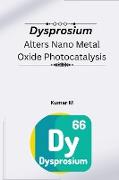- Start
- Dysprosium alters nano metal oxide photocatalysis
Dysprosium alters nano metal oxide photocatalysis
Angebote / Angebote:
Photocatalysis is a process of accelerating a chemical reaction using light energy, which has the potential to provide sustainable and green technologies for a wide range of applications. Metal oxides, such as CeO2, ZnO, and Bi2O3, are important photocatalysts due to their excellent catalytic properties and ease of synthesis. However, these metal oxides have some limitations, such as low photocatalytic efficiency, rapid recombination of photo-induced electron-hole pairs, and poor stability, which hinder their practical application. To overcome these limitations, researchers have explored the use of dopants, such as dysprosium (Dy), to modify the properties of these metal oxides.
Dysprosium is a rare earth element that has unique electronic and magnetic properties, which make it an interesting dopant for metal oxide photocatalysts. Several studies have investigated the effects of dysprosium doping on the properties of CeO2, ZnO, and Bi2O3 photocatalysts. These studies have shown that dysprosium alters the properties of the metal oxides, resulting in improved photocatalytic performance.
One of the main effects of dysprosium doping is the narrowing of the bandgap of the metal oxide semiconductor. The bandgap is the energy difference between the valence band and the conduction band, which determines the energy required for an electron to move from the valence band to the conduction band. Narrowing of the bandgap reduces the energy required for electron transfer, which increases the photocatalytic activity of the metal oxide. For example, a study by Zhang et al. (2020) showed that dysprosium-doped CeO2 had a narrower bandgap than undoped CeO2, which resulted in increased photocatalytic activity for the degradation of organic pollutants.
Another effect of dysprosium doping is the modification of the surface properties of the metal oxide. Dysprosium can form oxygen vacancies on the metal oxide surface, which serve as active sites for catalytic reactions. The oxygen vacancies also trap photo-induced electrons, which reduces the recombination rate of electron-hole pairs and increases the photocatalytic efficiency of the metal oxide. For instance, a study by Li et al. (2019) demonstrated that dysprosium-doped Bi2O3 had a higher concentration of oxygen vacancies than undoped Bi2O3, which enhanced its photocatalytic activity for the degradation of dyes.
Furthermore, dysprosium doping can also enhance the visible light absorption of metal oxide photocatalysts. Metal oxide photocatalysts typically have a high absorption of ultraviolet (UV) light, which accounts for only a small fraction of the solar spectrum. Dysprosium doping can extend the absorption range of the metal oxide to the visible light region, which increases the overall photocatalytic activity. For example, a study by Guo et al. (2018) showed that dysprosium-doped ZnO had a higher visible light absorption than undoped ZnO, which resulted in increased photocatalytic activity for the degradation of organic pollutants.
In conclusion, dysprosium doping has been shown to alter the properties of metal oxide photocatalysts, resulting in improved photocatalytic performance. Dysprosium modifies the bandgap, surface properties, and visible light absorption of metal oxide photocatalysts, which enhances their photocatalytic efficiency and stability. These findings have important implications for the development of sustainable and green technologies for environmental remediation, energy conversion, and chemical synthesis.
Folgt in ca. 15 Arbeitstagen

